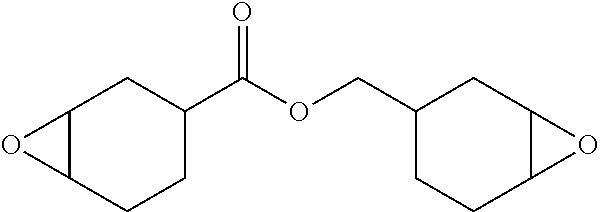Radiation curable composition, and method for preparing a hybrid sol-gel layer on a surface of a substrate using said composition
a technology of curable composition and hybrid solgel, which is applied in the direction of coatings, anti-corrosion paints, epoxy resin coatings, etc., can solve the problems of high energy required for heating and maintenance, affecting the environment, and limited use of elementary parts of solgel layers
- Summary
- Abstract
- Description
- Claims
- Application Information
AI Technical Summary
Benefits of technology
Problems solved by technology
Method used
Image
Examples
example 1
[0356]In this example, aluminium alloy panels coated with a cured hybrid sol-gel layer are prepared by the procedure outlined hereinabove using the following inventive radiation curable formulation (Formulation 1):
[0357]Formulation 1:[0358]Cationic curable resin: Epalloy® 5000 / Diepoxide of the cycloaliphatic alcohol[0359]Hydrogenated Bisphenol A (55.30 wt %);[0360]Organo mono(trialkoxysilane): C8TMS (n-octyl trimethoxysilane) (18.5 wt %);[0361]Poly(alkoxysiloxane): PDMOS / poly(dimethoxy siloxane) with n=5 (18.5 wt %);[0362]Cationic photoinitiator: 1250 / (4-methylphenyl) [4-(2-methylpropyl)phenyl]iodonium hexafluorophosphate (2.7 wt %);[0363]Corrosion inhibitor: 5% wt Shieldex® AC3.
[0364]The same results are obtained when changing Shieldex® AC3 to Pr2O3.
[0365]Characterization results of the samples prepared using this Formulation 1:[0366]Thickness (ISO 2360:2003): 20-28 μm;[0367]Solvent resistance (ISO 2812-1:1993): >2 hours;[0368]SST Tests (NF EN ISO 9227:2007): >2000 hours;[0369]Cros...
example 2
[0370]In this example, aluminium alloy panels coated with a cured hybrid sol-gel layer are prepared by the procedure outlined hereinabove using the following inventive radiation curable formulation (Formulation 2):
Formulation 2:
[0371]Cationic curable resin: Epalloy® 5000 Diepoxide of the cycloaliphatic alcohol[0372]hydrogenated Bisphenol A (49.4 wt %);[0373]Organo mono(trialkoxysilane): C8TMS (n-octyl trimethoxysilane) (19.7 wt %)[0374]Organo bis(trialkoxysilane): 1,2-bis(trimethoxysilyl)decane: 29.6 wt %[0375]Cationic photoinitiator: 1250 / (4-methylphenyl)[4-(2-methylpropyl)phenyl]iodonium[0376]hexafluorophosphate (1.3 wt %);[0377]Characterization results of the samples prepared using this Formulation 2.[0378]Thickness (ISO 2360:2003): 20-28 μm;[0379]Solvent resistance (ISO 2812-1:1993): >2 hours;[0380]SST Tests (NF EN ISO 9227:2007): >3000 hours;[0381]Cross-cut Test (ISO 2409:2007): Pass (Class 0).
example 3
[0382]In this example, aluminium alloy panels coated with a cured hybrid sol-gel layer are prepared by the procedure outlined hereinabove using the following comparative radiation curable formulation (Formulation 3):
[0383]Formulation 3:[0384](i) 2.7 wt % (4-methylphenyl)[4-(2-methylpropyl)phenyl]iodonium hexafluorophosphate.[0385](ii) The remaining to 100 wt % being Diepoxide of the cycloaliphatic alcohol hydrogenated Bisphenol A and C8TMS (n-octyl trimethoxysilane) in a 60 / 40 ratio (wt / wt).
[0386]Characterization results of the samples prepared using this Formulation 3:[0387]Thickness (ISO 2360:2003): 20-28 μm;[0388]Solvent resistance (ISO 2812-1:1993): [0389]SST Tests (NF EN ISO 9227:2007): ˜1500 hours;[0390]Cross-cut Test (ISO 2409:2007): Pass (Class 0).
PUM
| Property | Measurement | Unit |
|---|---|---|
| temperature | aaaaa | aaaaa |
| temperature | aaaaa | aaaaa |
| temperature | aaaaa | aaaaa |
Abstract
Description
Claims
Application Information
 Login to view more
Login to view more - R&D Engineer
- R&D Manager
- IP Professional
- Industry Leading Data Capabilities
- Powerful AI technology
- Patent DNA Extraction
Browse by: Latest US Patents, China's latest patents, Technical Efficacy Thesaurus, Application Domain, Technology Topic.
© 2024 PatSnap. All rights reserved.Legal|Privacy policy|Modern Slavery Act Transparency Statement|Sitemap



